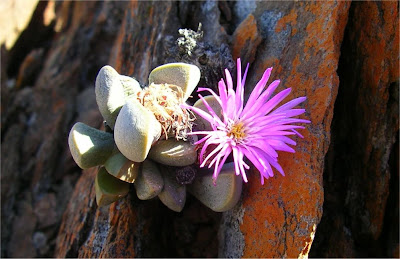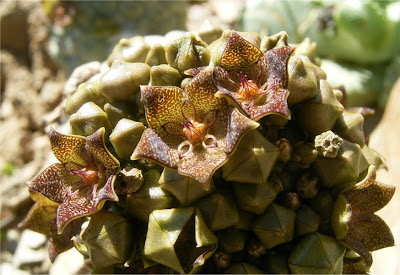Aloe bowiea is in many respects unlike other Aloe species and it was previously known as Chamaealoe africana. The differences are not significant enough however to warrant a seperate genus.
It is a small Aloe plant, reaching a height of about 140 mm. Aloe bowiea has a very limited distribution in the vicinity of Port Elizabeth, and due to urban as well as industrial development, the numbers have dwindled considerably. The species is now regarded as endangered
The greenish-brown flowers are rather insignificant and small.
Aloe bowiea suckers from the base quite prolifically and is easy to cultivate.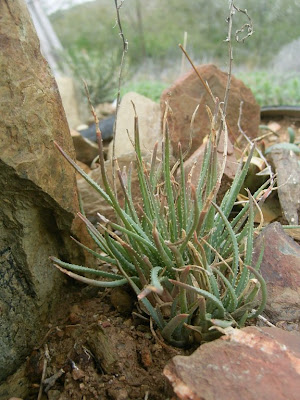
Aloe gariepensis is restricted to the very arid northern boundary of the Northern Cape. Although the distribution is limited, the plants occur in fairly large numbers and Aloe gariepensis is not threatened.
The flowering time is from July to September and the flowers are yellow, or sometimes bicoloured with red buds while the open flowers are yellow.
Aloe gariepensis is a difficult Aloe to cultivate and should be cultivated in desert conditions similar to its habitat. Aloe gariepensis in habitat.
Aloe gariepensis in habitat.
Aloe haemanthifolia is not a desert plant.
This rare and exotic Aloe is restricted to high mountain peaks in the area from Stellenbosch to Ceres. It is a critically rare species and almost impossible to cultivate.
The leaves resemble somewhat those of the popular bulb Haemanthus, hence the species name haemanthifolia. The flowering time is from September to December. Aloe haemanthifolia in habitat.
Aloe haemanthifolia in habitat.
Family: Agavaceae
Distribution: Northen Mexico
Photographs: Desert Plants
This is probably the most beautiful Agave species and is widely cultivated as an ornamental plant. Agave victoria-reginae is native to the Chichuahuan desert in Northern Mexico. Agave victoria-reginae
Agave victoria-reginae
It is a small species and reaches a diameter of approximately 60 cm.
Like all Agaves, the plants flower sometime after reaching maturity, which may take about 15 years. After flowering the plant dies. Most Agaves produce new plants from their roots during their lifetime. This is often not the case with Agave victoria-reginae.
Euphorbia fusca is a medusa- head Euphorbia, with a diameter of up to around 200 mm. The plants are easily recognized by the furrow in the apex of the main stem of adult plants. The body of Euphorbia fusca protrudes above the ground, similar to some other Great Karoo Euphorbias.
The distribution of the plants is in the Northern Karoo, Botswana and Namibia.
Propagation is from seed.
I have found the plants a bit more difficult to cultivate then some other similar species. They are rather prone to rot.
Aloe glauca occurs scattered over a long stretch along the dry western parts of South Africa. The southern limit of its distribution is around Swellendam while the plants are found up to Steinkopf in the north.
"Glauca" is the Latin word for grey referring to the blue-grey leaves of the plants. Local names include "Blouaalwyn" (Translate: Blue aloe) Aloe glauca . An attractive form from south of Laingsburg.
Aloe glauca . An attractive form from south of Laingsburg.
The plants vary considerably over their distribution range.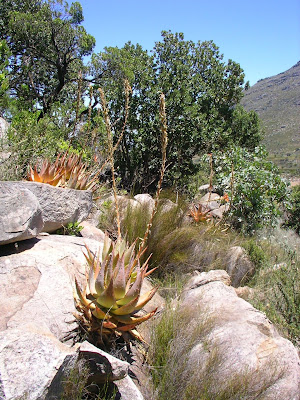 Aloe glauca from near Citrusdal.
Aloe glauca from near Citrusdal.
The flower colour varies from pink to pale orange.
Astrophytum ornatum is native to the Hidalgo and Queretaro districts of Mexico. This cactus is globular when young becoming columnar with age. Astrophytum ornatum becomes larger then the other members of the genus, reaching a height of 35 cm or more.
Cultivation is not difficult. Good drainage of the soil is essential. Adult plants grow outside in the rockery at Leopoort and can easily withstand temperatures of -2 deg Celsius in winter. Young plants need to be protected from frost. Water sparingly during the winter months.
The yellow blooms appear during the warmer months. Astrophytum ornatum, a large old plant in cultivation at Leopoort.
Astrophytum ornatum, a large old plant in cultivation at Leopoort. Astrophytum ornatum flower.
Astrophytum ornatum flower.
(Syringodea longituba var violaceae)
Family: Iridaceae
Distribution: Southern Cape, Western Cape, Western Karoo
Images: Desert Plants
Syringodea longituba var violaceae differs from the typical variety, Syringodea longituba variety longituba in that it has a white or violet throat whereas the typical variety has a yellow or orange throat. Syringodea longituba variety violacea
Syringodea longituba variety violacea Syringodea longituba variety violacea
Syringodea longituba variety violacea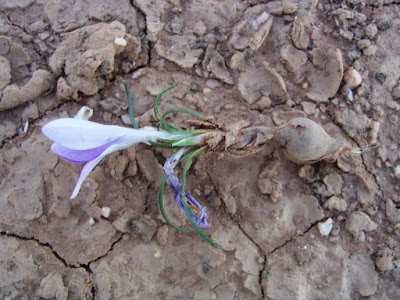 Syringodea longituba var violacea .
Syringodea longituba var violacea .
Under good conditions the bulbs can penetrate up to 10 cm into the soil.
It is a winter growing bulb, The flowers are shortlived and appear successively in batches. The flower color varies from violet to blueish-violet Syringodea longituba var violacea
Syringodea longituba var violacea
An exceptionally dense population South of Oudtshoorn.
Similar to Aloe variegata , Aloe aristata makes a good rockery plant and is relatively easy to grow .
The propagation is from seed or the removal of suckers.
Aloe aristata in cultivation.
Synonym: Serelei (The slippery one)
Diplosoma retroversum is one of the two species recognized in the genus. Diplosoma retroversum occurs in the Western Cape in the Piketberg district. The plants form clumps of flat growth. The plant body consists of two soft pulpy opposite leaves.
The flowers of Diplosoma retroversum are reddish to white. Diplosoma retroversum in habitat.
Diplosoma retroversum in habitat. Diplosoma retroversum.
Diplosoma retroversum.
Aloe barberae is found in a broad coastal zone from the Eastern Cape to Mozambique and is a majestic tree aloe (boomaalawyn Afr:) that can grow to 18 meters in height.
Although essentally a forest dweller, Aloe barberae adapts well to many different garden conditions, can withstand a reasonable amount of drought, but should be protected from severe frost. Similar to others in the genus, Aloe barberae is susceptible to snout beetle attacks. Due to the large size of the plants treatment is often overlooked as the evidence is not always visible in the early stages.
The flower colour is orange-pink or orange-red
If watered regularly, Aloe barberae is a robust grower.
The plants were previously known under the name Aloe bainesii. Aloe barberae in cultivation.
Aloe barberae in cultivation.
Family: Hyacinthaceae
Distribution: Little Karoo: Calitzdorp and Oudtshoorn.
Images: Desert Plants
Ornithogalum sardienii is a small bulb that is found only at a few isolated places in the Calitzdorp and Oudthoorn districts. The bulbs grow above the ground and multiply by making offsets. The flowers are small and white. At this specific locality the bulbs nestle in small shale crevices on a hill slope. Ornithogalum sardienii
Ornithogalum sardienii
Cheiridopsis pillansii is an interesting and attractive small fig-marigold from the arid Richtersveld in South Africa.
The genus consists of around a 100 species that inhabit areas of Namibia, the Northern Cape and the Western Cape.
Propagation is from seed or cuttings.
Fresh seed of Echinocactus grusonii available here:
Echinocactus grusonii is one of the most sought after cactus species. With its golden yellow recurved spines and neat spherical appearance this cactus has become a common house and garden plant all over the world. The Golden Barrel Cactus, or Mother in law's cushion, as the plants are often referred to, do well in hot sunny climates.
The plants originate from the desert regions of Mexico, San Luis Potosi to Hidalgo. Echinocactus grusonii can withstand mild frost during the winter months in cultivation. The soil should be well drained, and although the plants can often withstand regular watering during the summer, the chances of rot will also increase considerably. Watering should be kept to a minimum during the winter months.
When growing Echinocactus grusonii as a house plant, a sunny position is advisable. The plants can last indoors for many years, but do have a tendency to elongate unnaturally due to the lack of sunlight.
Golden Barrel Cactus Seed Sale.
Euphorbia coerulescens forms huge clumps in the the Eastern Cape, especially around Jansenville. Euphorbias are often in Afrikaans referred to as "Noors" . The area around Jansenville is also called the "Noorsveld" as large areas are covered by this species. There is an adjunct locality of Euphorbia coerulescens at Calitzdorp in the Little Karoo, which is a few hundred kilometers to the west of Jansenville.
Lithops marmorata variety elisae is known from a small area north of Steinkopf in the Northern Cape Richtersveld.
Synonyms for Lithops include Bokspoortjie, Beeskloutjie. (tranlated: goat tracks or cattle tracks)
Pseudolithos caput-viperae ( Pseudo lithos = resembling a stone) is native to Somalia. The plants belong to the family Apocynaceae, the same family that Stapelias and Hoodia belong to.
The strange monster-like shape of Pseudolithos caput-viperae make this plant a choice addition to any collection.
Pseudolithos caput-viperae can be grown from seed or cuttings. Growth is very slow.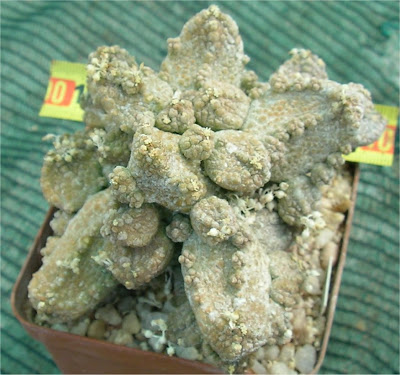 Pseudolithos caput-viperae. An old cultivated plant.
Pseudolithos caput-viperae. An old cultivated plant.
Euphorbia sepulta is small branching succulent plant from Somalia.
The shape of the plant is somewhat similar to to the South African medusa head Euphorbias, especially Euphorbia susannae.
Euphorbia sepulta is very slow growing in cultivation and the plants are often grafted on other Euphorbia species.
Larryleachia perlata is a small spineless succulent from the family Apocynaceae. Larryleachias are related to the genus Hoodia. The plants are found in very hot and arid places in the Northern Cape including the Richtersveld desert.
Larryleachia perlata is easy to grow from seed which germinates readily. The plants are however rather difficult to keep alive. They often succumb to rot due to over watering, and are susceptible to Fusarium attack.
The plants should be kept dry in winter and the minimum temperature should preferable not be below -3 deg Celsius, although some literature suggests that the plants can withstand considerably lower temperatures. Larryleachia perlata from Vaalheuwel.
Larryleachia perlata from Vaalheuwel.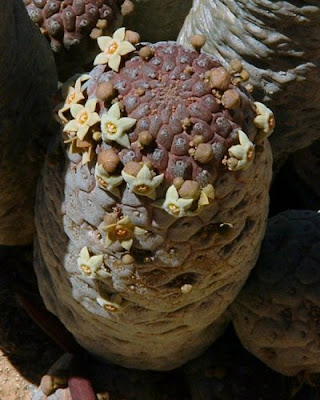 Larryleachia perlata from Hellskloof.
Larryleachia perlata from Hellskloof.
Pelargonium alternans is a succulent low growing shrub.The plants are usually found on hillsides and rocky elevations.
The distribution of Pelargonium alternans includes the Great Karoo, Little Karoo and Tanqua Karoo.
In Afrikaans this plant is generally referred to as Blomkoolmalva (Eng: Cauliflower geranium).
Hoodia flava was previously known as Trichocaulon flavum. The Trichocaulons were the succulent desert plants eaten by the Bushmen to suppress appetite and thirst while on hunting expeditions. Although the bitter tasting Hoodia gordonii is often hailed as the plant the Bushmen ate for this purpose the sweet tasting Hoodia flava ( Afrikaans "Soetghaap" translated as "Sweet Ghaap") along with other Trichocaulons was much prefered .
Hoodia flava is widely distributed in the semi-desert regions of the Great Karoo and Namibia. It is one of the widest spread Hoodia species although by no means common. There seem to be some larger populations between Britstown and Beaufort West.
The plants grow well in cultivation, but Hoodia flava rot more easily then some other Hoodia.
Hoodia flava plants are rather variable in size. Some adult plants may reach a size of of 50 cm, but most remain small, less then 10 cm. Hoodia flava.
Hoodia flava.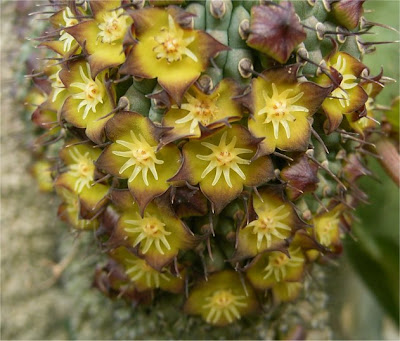 Hoodia flava flowers.
Hoodia flava flowers.
Unlike many Euphorbias in South Africa, Euphorbia multifolia and a few relatives are semi-evergreen. The plants may or may not shed their leaves during the hot summer. Prefering higher altitudes, Euphorbia multifolia is usually found on mountain slopes of the Swartberg or hillsides near the mountain.The distribution is in the southern Great Karoo and Little Karoo.
Propagation is from seed or cuttings.
The cultivation of Euphorbia multifolia is not difficult and plants may grow relatively fast if given enough root space. Overwatering can lead to early death though.
